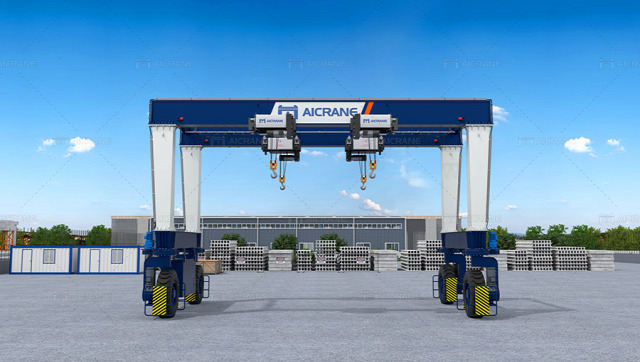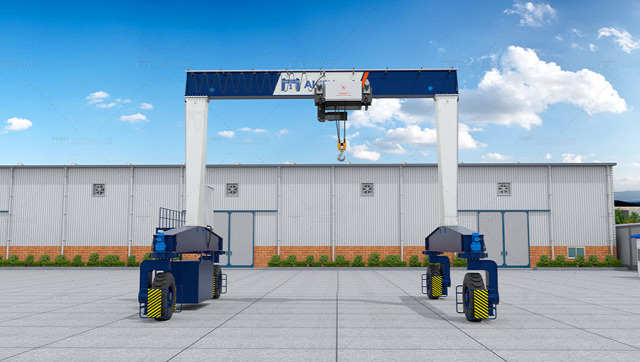Gantry cranes are versatile lifting solutions used across various industries, from manufacturing and construction to shipyards and logistics. Among the different types of gantry cranes, two popular categories are rubber tyred mobile gantry cranes (RTGs) and fixed gantry cranes. Each type offers unique advantages and limitations, making them suitable for specific applications. This article provides a comparative analysis of rubber tyred mobile gantry cranes and fixed gantry cranes, focusing on their features, applications, advantages, and limitations to help businesses choose the right crane for their needs.

Overview of Rubber Tyred Mobile Gantry Cranes
Rubber tyred gantry cranes (RTG cranes) are mobile cranes equipped with rubber tires, allowing them to move freely within a facility or outdoor yard. These cranes are particularly common in container terminals, where they are used for stacking and moving containers. Their mobility is facilitated by diesel or electric power, and they are capable of operating in multiple directions, providing flexibility in handling operations.
Key Features of Rubber Tyred Mobile Gantry Cranes:
- Mobility: Equipped with rubber tires and steering mechanisms, RTGs can move across various terrains, including uneven surfaces.
- Steering Modes: Modern RTGs often feature multiple steering modes, such as straight, diagonal, carousel, and crab steering, enhancing maneuverability.
- Lifting Capacity: Typically ranging from 10 to 120 tons, with the possibility of custom configurations for higher capacities.
- Power Source: Available in diesel-powered, hybrid, or fully electric models, catering to diverse operational and environmental needs.
- Flexibility: RTGs are versatile and can be used in various applications, such as container handling, steel yards, and logistics centers.

Overview of Fixed Gantry Cranes
Fixed gantry cranes, also known as stationary gantry cranes, are permanently installed cranes that provide lifting solutions in a fixed location. These cranes are often used in manufacturing facilities, warehouses, and workshops where lifting tasks are repetitive and localized. Fixed gantry cranes can come in single or double girder gantry configurations and can be customized based on specific operational requirements.
Key Features of Fixed Gantry Cranes:
- Permanent Installation: Fixed in place, typically on rails or a concrete foundation, ensuring stability and strength.
- Higher Lifting Capacity: Can handle heavy loads, often exceeding 200 tons, making them suitable for heavy-duty applications.
- Customization: Available in various configurations, including single girder, double girder, and cantilevered designs, to suit different lifting needs.
- Reliable Power Source: Operated using a fixed power source, usually electricity, providing consistent power without the need for fuel replenishment.
- Precision: Fixed gantry cranes offer precise and controlled movements, making them ideal for manufacturing and assembly operations where accuracy is crucial.
Comparative Analysis of Rubber Tyred Mobile Gantry Cranes vs. Fixed Gantry Cranes
1. Mobility and Flexibility
One of the most significant differences between rubber tyred mobile gantry cranes and fixed gantry cranes is their mobility. RTGs offer unparalleled mobility, allowing them to move freely across a facility or yard. This feature makes them ideal for operations requiring frequent relocation or where lifting points vary. For instance, in container yards, RTGs can travel between rows of containers and stack them efficiently.
In contrast, fixed gantry cranes are designed for stationary use and are ideal for applications where the lifting task is confined to a specific area. Fixed cranes are common in workshops, assembly lines, and manufacturing facilities, where their inability to move is offset by their higher lifting capacity and stability.
2. Installation and Setup
RTGs offer a significant advantage in terms of installation and setup. Being mobile, they do not require a fixed foundation or complex installation processes. This reduces the setup time and costs associated with crane deployment. However, RTGs may require regular maintenance of tires, engines, and other mobile components to ensure optimal performance.
On the other hand, fixed gantry cranes require a more involved installation process, including constructing a foundation, installing rails (if needed), and setting up electrical connections. This fixed installation often translates to higher initial setup costs and time. However, once installed, fixed gantry cranes are highly reliable and require less frequent maintenance compared to their mobile counterparts.
3. Lifting Capacity and Range
Fixed gantry cranes generally offer a higher lifting capacity than rubber tyred mobile gantry cranes. They can handle loads well above 200 tons, making them suitable for heavy-duty applications, such as steel mills, shipbuilding, and heavy machinery manufacturing. The fixed nature of these cranes provides better stability and structural integrity, allowing them to lift heavier loads safely.
RTGs, while versatile and mobile, are typically limited to lifting capacities ranging from 10 to 120 tons. They are more suitable for medium-duty applications, such as container handling, material stacking, and logistics operations. For businesses needing to move heavy loads within a defined area, fixed gantry cranes are often the better choice.
4. Operational Efficiency
RTGs excel in environments where operational flexibility is a priority. Their ability to move around and adapt to different tasks allows for more dynamic workflows, especially in container terminals or large yards. Additionally, RTGs with multiple steering modes provide greater control and efficiency in confined spaces.
Fixed gantry cranes, however, offer superior precision and control, which is critical in assembly lines, workshops, and facilities where repetitive tasks are performed. The fixed position of these cranes allows for precise movement and accurate load placement, enhancing productivity in controlled environments.
5. Power Consumption and Environmental Impact
Power consumption and environmental considerations are becoming increasingly important in selecting lifting equipment. Fixed gantry cranes are typically powered by electricity, making them energy-efficient and environmentally friendly. With advancements in regenerative braking and energy-saving technologies, these cranes can further reduce power consumption and operational costs.
Rubber tyred mobile gantry cranes, especially diesel-powered models, may have higher fuel consumption and environmental impact due to emissions. However, modern RTGs are increasingly adopting hybrid or fully electric power sources, which reduce fuel costs and minimize environmental impact. Businesses looking to lower their carbon footprint should consider electric or hybrid RTGs or opt for fixed gantry cranes.
6. Cost Considerations
The cost of a gantry crane depends on several factors, including its type, size, capacity, and customization level. Generally, fixed gantry cranes have higher initial installation costs due to foundation construction, electrical setup, and rail installation. However, they tend to have lower long-term maintenance costs and a longer lifespan.
Rubber tyred mobile gantry cranes have lower initial setup costs since they do not require a foundation or fixed infrastructure. However, they may have higher maintenance costs due to the wear and tear of tires, engines, and mobility components. Fuel or energy costs for mobile operations should also be considered.
Conclusion
Choosing between rubber tyred mobile gantry cranes and fixed gantry cranes depends on the specific operational requirements, budget, and site conditions. RTGs are ideal for applications requiring mobility, flexibility, and quick deployment, such as container handling and logistics operations. On the other hand, fixed gantry cranes are more suitable for heavy-duty, precise, and repetitive tasks in manufacturing, assembly, and heavy industries.
Both types of gantry cranes offer unique advantages and limitations. Businesses must carefully assess their needs, consider the crane's mobility, capacity, installation requirements, operational efficiency, power consumption, and cost before making a decision. By doing so, they can choose the crane type that best suits their operational demands, ensuring optimal performance and productivity.

